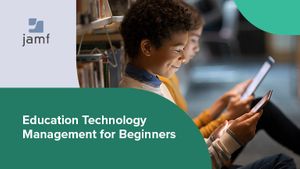One award-winning New Zealand school is using technology in a groundbreaking program that imparts cutting-edge skills while fostering connections with tradition, community and environment. After reviewing many potential solutions, administrators have found that the combination of Apple and Jamf is best suited to delivering individualized instruction for a diverse population of learners.
Te Akau ki Papamoa Primary School’s educational mission
Nestled between the beach and the Papamoa Hills outside the coastal city of Tauranga, Te Akau ki Papamoa Primary School is an Apple Distinguished School serving first- to sixth-grade students. With 941 Apple devices currently in use – mostly iPads provided to students on a one-to-one basis, while teachers use MacBooks – the school provides a technology-mediated learning experience designed to unlock the potential within each student and to cultivate lifelong learning. “We have a mantra here at school: ‘Know me before you teach me,’ which really encompasses every individual,” explains Bruce Jepsen, who has served as principal for 15 years.
Te Akau ki Papamoa’s pioneering e-learning system constitutes one component of this educational model, which also includes a wide range of intensive sports programs, a house system for organizing the student body and a dedicated radio station that delivers daily te reo Māori (Māori language) lessons. Students can write and publish books and construct animations, finding personalized ways to express their voices and stories.
A localized curriculum is key to the experience that educators at the school focus on providing. Students explore the landscape of the surrounding area and learn about the whenua (land) and its original inhabitants, but they also examine their own whakapapa, the connectedness that defines the role that they play as individuals situated in the physical and cultural geography. Teachers and administrators strive to foster an environment both inside the school and beyond its walls that is dynamic and conducive to learning and building communal connections.
Empowering education with Apple devices
Much thought went into the development of Te Akau ki Papamoa’s model of providing each student with a personalized iPad. “When we started to unpack one-to-one digital technology and the part that it can play, we wanted everyone to have equal digital access,” says Principal Jepsen. “We wanted everyone to have a device and we wanted that to be the platform.” The school chose iPad as a uniquely suitable device for education, with its intuitive interface and powerful learning software.
Leveraging Apple technology allows teachers to go beyond traditional classroom activities to deliver meaningful learning experiences. After studying local legends, students collaborated in writing and illustrating their own stories. Using the iPad, the learners were able to traverse the entire process of authoring and digitally publishing original picture books.
The mobility of the iPad and its built-in camera also feature heavily in the daily educational experience. “The best thing about it is that an iPad, you literally can take anywhere out of the four walls,” says teacher Richard Williams. “We could take it to the beach, we take it up Papamoa Hills. We can take it anywhere we want.” Having the iPad handy as a tool to record spontaneous thoughts and observations makes it easier for students to be attentive to their environment and to tap into unexpected sources of creativity.
Apple technology is particularly valuable in this context when it simply becomes a part of the environment rather than an artifact calling attention to itself. “It's certainly how the technology helps support us with our learning, rather than the other way around,” Jepsen notes. “It's not often we actually talk about technology. We talk about the tools that we've got and how we use them and how we might communicate our voice.”
Using Jamf School for customized learning experiences
Educators at Te Akau ki Papamoa Primary School credit Jamf School as an essential tool for managing Apple technology in a way that enhances its adaptability and ease of use. Part of this is being able to easily set up individual iPad profiles instead of using a one-size-fits-all solution. Profiles may feature different apps and user permissions according to the needs of the class level, the teachers’ preferences and the unique strengths and interests of the students. Jamf also provides the capability of monitoring students’ activities to make sure that they are not accessing harmful content or using their devices inappropriately for the learning environment; when necessary, administrators can lock an iPad until a problem has been resolved.
Setting up and reprovisioning devices is easier for staff now that Jamf powers their fleet of devices. “It used to take days and weeks to set up iPads… now it just takes us a day to set it up,” says Williams. “With a click of a button, we can set up profiles, we can troubleshoot, we can do pretty much everything we need to do to make sure the iPad runs really well in the classroom. Whereas before sometimes we would waste time by looking for… lost passwords, now we can wipe a device and we can reset it.”
Relying on the combination of Jamf and Apple also made the transition into virtual learning for the COVID-19 pandemic a much less painful process. “When we went into lockdown, our students went straight into their usual program, from home, the next day,” explains assistant principal Dorothea Collier. “There was no having to figure something out, because they were actually used to working off their iPads, and our teachers are used to setting up their activities that way. So, their learning just continued. It was seamless.”
Emerging as a leading force in primary education
Te Akau ki Papamoa’s e-learning program is key to the school’s emergence as a driving force in pedagogical innovation.“I'm really proud of where we're at in terms of acknowledgement of the profile we have in that space,” says Principal Jepsen. “So the school has a reputation as being a national leader and also a global player in the delivery of what could be called a digitized curriculum.”
The school’s growing reputation has culminated in continued recognition by the Apple Distinguished School program, which seeks to call attention to schools using technology in novel ways to advance learning goals. “I value that. It's more the depth of what that actually means than the title itself,” Jepsen acknowledges. “I'm talking about children learning how to navigate area and volume and mass through the use of digital technologies in such a way that they're able to design and create property, buildings, structures that are probably equivalent to CAD drawing at first- and second-year university. I'm talking about year-one children, that when we use our curriculum and we measure where they are in terms of national norms of the understanding of the technology curriculum, that our year-ones are coming out as year-three and -four, that our year-sixes are off the chart in terms of innovative thinking, computational thinking.”
Curious about how Jamf School can power educational innovation and help produce improved learning outcomes for your school? Visit the product page for more information.
by Category:
Have market trends, Apple updates and Jamf news delivered directly to your inbox.
To learn more about how we collect, use, disclose, transfer, and store your information, please visit our Privacy Policy.




